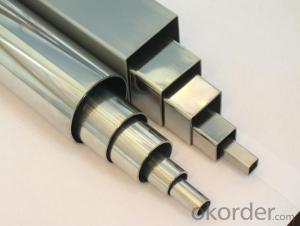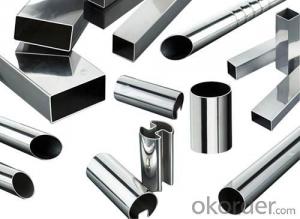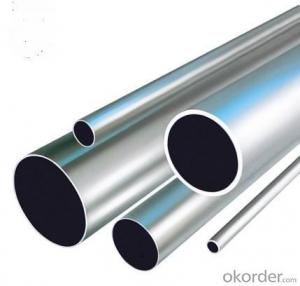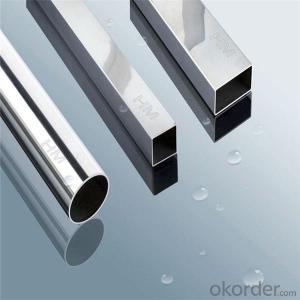STAINLESS STEEL PIPES 201
- Loading Port:
- China Main Port
- Payment Terms:
- TT OR LC
- Min Order Qty:
- -
- Supply Capability:
- -
OKorder Service Pledge
OKorder Financial Service
You Might Also Like
Description:
Stainless Steel Pipe
Material:
304 321 316 310
Packing:
In bundle
MOQ:
5 TONS
Comparison of standardized steels
| EN-standard Steel no. k.h.s DIN | EN-standard Steel name | SAE grade | UNS |
|---|---|---|---|
| 1.4109 | X65CrMo14 | 440A | S44002 |
| 1.4112 | X90CrMoV18 | 440B | S44003 |
| 1.4125 | X105CrMo17 | 440C | S44004 |
| | | 440F | S44020 |
| 1.4016 | X6Cr17 | 430 | S43000 |
| 1.4408 | G-X 6 CrNiMo 18-10 | 316 | |
| 1.4512 | X6CrTi12 | 409 | S40900 |
| | | 410 | S41000 |
| 1.4310 | X10CrNi18-8 | 301 | S30100 |
| 1.4318 | X2CrNiN18-7 | 301LN | |
| 1.4307 | X2CrNi18-9 | 304L | S30403 |
| 1.4306 | X2CrNi19-11 | 304L | S30403 |
| 1.4311 | X2CrNiN18-10 | 304LN | S30453 |
| 1.4301 | X5CrNi18-10 | 304 | S30400 |
| 1.4948 | X6CrNi18-11 | 304H | S30409 |
| 1.4303 | X5CrNi18-12 | 305 | S30500 |
| | X5CrNi30-9 | 312 | |
| 1.4541 | X6CrNiTi18-10 | 321 | S32100 |
| 1.4878 | X12CrNiTi18-9 | 321H | S32109 |
| 1.4404 | X2CrNiMo17-12-2 | 316L | S31603 |
| 1.4401 | X5CrNiMo17-12-2 | 316 | S31600 |
| 1.4406 | X2CrNiMoN17-12-2 | 316LN | S31653 |
| 1.4432 | X2CrNiMo17-12-3 | 316L | S31603 |
| 1.4435 | X2CrNiMo18-14-3 | 316L | S31603 |
| 1.4436 | X3CrNiMo17-13-3 | 316 | S31600 |
| 1.4571 | X6CrNiMoTi17-12-2 | 316Ti | S31635 |
| 1.4429 | X2CrNiMoN17-13-3 | 316LN | S31653 |
| 1.4438 | X2CrNiMo18-15-4 | 317L | S31703 |
| 1.4362 | X2CrNi23-4 | 2304 | S32304 |
| 1.4462 | X2CrNiMoN22-5-3 | 2205 | S31803/S32205 |
| 1.4539 | X1NiCrMoCu25-20-5 | 904L | N08904 |
| 1.4529 | X1NiCrMoCuN25-20-7 | | N08926 |
| 1.4547 | X1CrNiMoCuN20-18-7 | 254SMO | S31254 |
Stainless steel’s resistance to corrosion and staining, low maintenance and familiar lustre make it an ideal material for many applications. There are over 150 grades of stainless steel, of which fifteen are most commonly used. The alloy is milled into coils, sheets, plates, bars, wire, and tubing to be used in cookware, cutlery, household hardware, surgical instruments, major appliances, industrial equipment (for example, in sugar refineries) and as an automotive and aerospace structural alloy and construction material in large buildings. Storage tanks and tankers used to transport orange juice and other food are often made of stainless steel, because of its corrosion resistance. This also influences its use in commercial kitchens and food processing plants, as it can be steam-cleaned and sterilized and does not need paint or other surface finishes.
Stainless steel is used for jewelry and watches with 316L being the type commonly used for such applications. It can be re-finished by any jeweler and will not oxidize or turn black.
Some firearms incorporate stainless steel components as an alternative to blued or parkerized steel. Some handgun models, such as the Smith & Wesson Model 60 and the Colt M1911 pistol, can be made entirely from stainless steel. This gives a high-luster finish similar in appearance to nickel plating. Unlike plating, the finish is not subject to flaking, peeling, wear-off from rubbing (as when repeatedly removed from a holster), or rust when scratched.
Architecture[edit]
Stainless steel is used for buildings for both practical and aesthetic reasons. Stainless steel was in vogue during the art deco period. The most famous example of this is the upper portion of the Chrysler Building (pictured). Some diners and fast-food restaurants use large ornamental panels and stainless fixtures and furniture. Because of the durability of the material, many of these buildings retain their original appearance.
Type 316 stainless is used on the exterior of both the Petronas Twin Towers and the Jin Mao Building, two of the world's tallest skyscrapers.[17]
The Parliament House of Australia in Canberra has a stainless steel flagpole weighing over 220 tonnes (240 short tons).
The aeration building in the Edmonton Composting Facility, the size of 14 hockey rinks, is the largest stainless steel building in North America.
Bridges[edit]
Cala Galdana Bridge in Minorca (Spain) was the first stainless steel road bridge.
Sant Fruitos Pedestrian Bridge (Catalonia, Spain), arch pedestrian bridge.
Padre Arrupe Bridge (Bilbao, Spain) links the Guggenheim museum to the University of Deusto.[18]
Monuments and sculptures[edit]
The Unisphere, constructed as the theme symbol of the 1964-5 World's Fair in New York City, is constructed of Type 304L stainless steel as a sphere with a diameter of 120 feet, or 36.57 meters.
The Gateway Arch (pictured) is clad entirely in stainless steel: 886 tons (804 metric tonnes) of 0.25 in (6.4 mm) plate, #3 finish, type 304 stainless steel.[19]
The United States Air Force Memorial has an austenitic stainless steel structural skin.
The Atomium in Brussels, Belgium was renovated with stainless-steel cladding in a renovation completed in 2006; previously the spheres and tubes of the structure were clad in aluminium.
The Cloud Gate sculpture by Anish Kapoor, in Chicago US.
The Sibelius monument in Helsinki, Finland, is made entirely of stainless steel tubes.
The Man of Steel (sculpture) under construction in Rotherham, England.
Other[edit]
- Automotive bodies
The Allegheny Ludlum Corporation worked with Ford on various concept cars with stainless steel bodies from the 1930s through the 1970s, as demonstrations of the material's potential. The 1957 and 1958 Cadillac Eldorado Brougham had a stainless steel roof. In 1981 and 1982, the DeLorean DMC-12 production automobile used stainless steel body panels over a glass-reinforced plasticmonocoque. Intercity buses made by Motor Coach Industries are partially made of stainless steel. The aft body panel of the Porsche Cayman model (2-door coupe hatchback) is made of stainless steel. It was discovered during early body prototyping that conventional steel could not be formed without cracking (due to the many curves and angles in that automobile). Thus, Porsche was forced to use stainless steel on the Cayman.
- Passenger rail cars
Rail cars have commonly been manufactured using corrugated stainless steel panels (for additional structural strength). This was particularly popular during the 1960s and 1970s, but has since declined. One notable example was the early Pioneer Zephyr. Notable former manufacturers of stainless steel rolling stock included the Budd Company (USA), which has been licensed to Japan's Tokyu Car Corporation, and the Portuguese company Sorefame. Many railcars in the United States are still manufactured with stainless steel, unlike other countries who have shifted away.
- Aircraft
Budd also built an airplane, the Budd BB-1 Pioneer, of stainless steel tube and sheet, which is on display at the Franklin Institute.
The American Fleetwings Sea Birdamphibious aircraft of 1936 was also built using a spot-welded stainless steel hull.
The Bristol Aeroplane Company built the all-stainless steel Bristol 188 high-speed research aircraft, which first flew in 1963.
The use of stainless steel in mainstream aircraft is hindered by its excessive weight compared to other materials, such as aluminum.
- Jewelry
Valadium, a stainless steel and 12% nickel alloy is used to make class and military rings. Valadium is usually silver-toned, but can be electro-charged to give it a gold tone. The gold tone variety is known as Sun-lite Valadium
- Q: What is stainless steel pipe?
- Stainless steel pipe is a type of pipe made from an alloy of steel and chromium, with a high resistance to corrosion and staining. It is commonly used in various industries, including construction, automotive, and manufacturing, due to its durability and ability to withstand harsh environments.
- Q: Are stainless steel pipes suitable for fertilizer industries?
- Yes, stainless steel pipes are suitable for fertilizer industries. Stainless steel is highly resistant to corrosion, which is essential in an environment where fertilizers and other chemicals are present. Additionally, stainless steel pipes have high strength and durability, making them capable of withstanding the harsh conditions and pressures found in fertilizer production and handling processes.
- Q: What are the weight limitations for stainless steel pipes?
- The weight limitations for stainless steel pipes vary depending on several factors such as the grade of stainless steel, the pipe's dimensions, and the intended application. However, stainless steel pipes are known for their strength and durability, which allows them to withstand heavy loads. Generally, stainless steel pipes can support significant weight without deformation or failure. It is important to consult the manufacturer's specifications or engineering standards for precise weight limitations as they can provide the most accurate information specific to the particular type and size of stainless steel pipe being used.
- Q: How do stainless steel pipes compare to titanium pipes?
- Stainless steel pipes and titanium pipes exhibit distinct characteristics, catering to diverse applications based on specific needs. In terms of strength, titanium pipes generally outperform stainless steel pipes. Titanium possesses an impressive strength-to-weight ratio, making it an ideal choice for lightweight yet strong materials. Conversely, stainless steel is renowned for its excellent tensile strength and durability, albeit being relatively heavier than titanium. Regarding corrosion resistance, both stainless steel and titanium pipes demonstrate high resistance to corrosion. Nevertheless, titanium pipes offer superior corrosion resistance, particularly in aggressive environments like seawater or chemical processing applications. Stainless steel pipes also possess good corrosion resistance but might require additional coatings or treatments to enhance their resistance in certain conditions. Temperature resistance is another crucial aspect to consider. Titanium pipes can endure high temperatures without compromising their strength or structural integrity, making them suitable for high-temperature applications in industries such as aerospace or power generation. Stainless steel pipes also exhibit decent heat resistance, but their performance may vary depending on the specific grade of stainless steel and the temperature range involved. Cost is an essential factor as well. Generally, stainless steel pipes are more cost-effective compared to titanium pipes. Titanium, due to its scarcity, intricate fabrication process, and higher production costs, is a pricier material. Hence, if cost is a significant consideration, stainless steel pipes emerge as a more viable option. In conclusion, stainless steel pipes and titanium pipes possess their own merits and aptitude for distinct applications. Titanium pipes excel in terms of strength, corrosion resistance, and heat resistance but come at a higher cost. Stainless steel pipes offer satisfactory strength, corrosion resistance, and cost-effectiveness. Ultimately, the selection between the two relies on the specific requirements, budget, and intended application of the pipes.
- Q: What is the difference between 304F and 316F stainless steel pipes?
- The main difference between 304F and 316F stainless steel pipes lies in their composition and characteristics. 304F stainless steel is an austenitic stainless steel, which means it contains high levels of chromium and nickel. It is known for its excellent corrosion resistance, weldability, and formability. This makes it a popular choice for various applications, including pipes used in industries such as food processing, chemical processing, and construction. However, 304F stainless steel is not as resistant to chloride corrosion as 316F stainless steel. On the other hand, 316F stainless steel is also an austenitic stainless steel, but it contains higher levels of chromium, nickel, and molybdenum compared to 304F stainless steel. The addition of molybdenum provides enhanced corrosion resistance, particularly against chlorides and other aggressive chemicals. This makes 316F stainless steel pipes suitable for more demanding applications, such as marine environments, where exposure to saltwater and corrosive chemicals is common. In summary, the main difference between 304F and 316F stainless steel pipes is their corrosion resistance. While both are austenitic stainless steels, 316F stainless steel offers superior resistance to chloride corrosion, making it a better choice for applications where corrosion resistance is critical.
- Q: How are stainless steel pipes joined together?
- Stainless steel pipes are joined together through various methods such as welding, threading, and compression fittings.
- Q: Can stainless steel pipes be threaded?
- Indeed, stainless steel pipes possess the capability to be threaded. Threading encompasses the act of generating threads either internally or externally on a substance, facilitating effortless connection and assembly with additional components. Stainless steel, being an adaptable material, can undergo threading procedures that comprise both internal and external threading. The process of threading stainless steel pipes can be accomplished through diverse means, including manual threading, machine threading, or even the utilization of specialized threading tools. By threading stainless steel pipes, a steadfast and dependable connection is achieved, rendering it suitable for numerous applications within industries like plumbing, oil and gas, construction, and beyond.
- Q: How do you prevent backflow in stainless steel pipes?
- To prevent backflow in stainless steel pipes, there are a few key measures that can be taken. 1. Install a backflow preventer: This is a mechanical device that is installed in the pipe system to ensure that water flows in one direction and prevents any backflow. There are different types of backflow preventers available, such as check valves, double check valves, and reduced pressure zone devices. The selection of the appropriate backflow preventer depends on the specific requirements of the system and local codes and regulations. 2. Regular maintenance and inspection: It is important to regularly inspect the backflow preventer and ensure it is functioning properly. Any signs of wear or damage should be addressed immediately to prevent potential backflow issues. Regular maintenance can also include cleaning and replacing any worn-out parts to ensure optimal performance. 3. Pressure regulation: Maintaining proper pressure in the stainless steel pipes can also help prevent backflow. High pressure can cause water to flow in the opposite direction, leading to backflow. By installing pressure regulators or pressure-reducing valves, the water pressure can be controlled and maintained within the recommended range. 4. Air gaps: Incorporating air gaps in the system can provide an additional layer of protection against backflow. An air gap is a physical separation between the water source and the point of use, ensuring that there is no direct connection that could allow backflow to occur. 5. Adequate system design: Proper system design is crucial in preventing backflow. By ensuring that the stainless steel pipes have the correct sizing, appropriate slope, and proper connections, the risk of backflow can be minimized. Additionally, locating the backflow preventer in an easily accessible area can facilitate regular maintenance and inspection. By implementing these preventive measures, the risk of backflow in stainless steel pipes can be significantly reduced, promoting the safe and efficient flow of water in the system.
- Q: Can stainless steel pipes be used for chemical reactors?
- Yes, stainless steel pipes can be used for chemical reactors. Stainless steel is a popular choice for chemical reactors due to its excellent corrosion resistance properties. It is highly resistant to chemical reactions and is able to withstand the harsh conditions and corrosive nature of many chemicals used in industrial processes. Stainless steel also has high strength and durability, making it suitable for handling high-pressure and high-temperature applications commonly found in chemical reactors. Additionally, stainless steel is easy to clean and maintain, which is crucial for maintaining the purity and integrity of the chemicals being processed. Overall, stainless steel pipes are a reliable and efficient choice for chemical reactors.
- Q: Can stainless steel pipes be used for oil and gas refineries?
- Yes, stainless steel pipes can be used for oil and gas refineries. Stainless steel offers excellent corrosion resistance, high strength, and durability, making it suitable for handling various corrosive fluids and gases in the refining process. Additionally, stainless steel pipes can withstand high temperatures and pressures, ensuring the safe and efficient transportation of oil and gas in refineries.
Send your message to us
STAINLESS STEEL PIPES 201
- Loading Port:
- China Main Port
- Payment Terms:
- TT OR LC
- Min Order Qty:
- -
- Supply Capability:
- -
OKorder Service Pledge
OKorder Financial Service
Similar products
Hot products
Hot Searches
Related keywords























